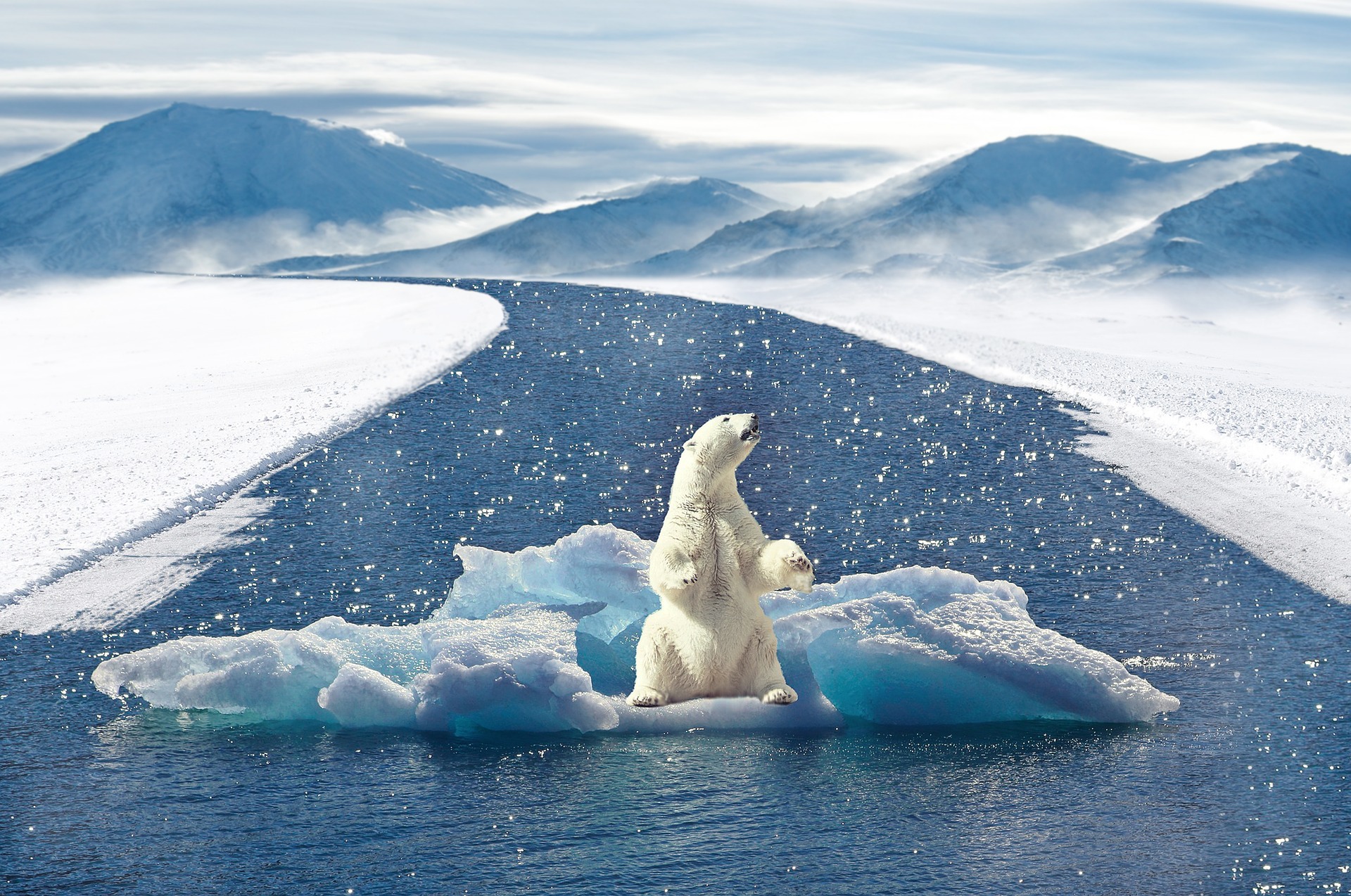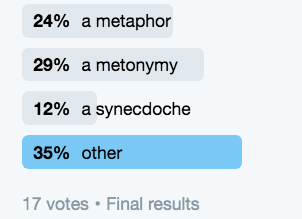
April 19, 2019, by Brigitte Nerlich
It’s an icon, it’s a symbol: It’s a polar bear!?
A while ago Saffron O’Neill asked me whether one should call polar bear images a climate change synecdoche or a climate change metonym? That was a good question and I should know the answer! Indeed she asked me because she thought I was an expert on that sort of stuff!
I have written about metaphors. I have also written about metonymy and, surprise surprise, about synecdoche. Together with Rusi Jaspal I have even written about visual images of extreme whether, an article that contains a small section on polar bears as cultural symbols.
I was therefore startled to find that I didn’t have a quick and definitive answer to Saffron’s question as to whether polar bears, or indeed polar bear images, were synecdoches or metonyms of climate change.
Metaphors, metonyms and synecdoches
Synecdoche is commonly seen as being based on a part-whole relationship, as in “I have got some new wheels” for “I have got a new car”. Metonymy is commonly seen as being based on wider sets of relations between interlinked things (or concepts), as in “The kettle is boiling” for “The water is boiling” or “The ham sandwich hasn’t paid yet” for “The costumer who ordered a ham sandwich hasn’t paid yet”. (And here is a whole book on metonymy by Jeannette Littlemore)
What then are polar bears/polar bear images in the context of climate change? They are part of a whole network of relations and associations in which the issue of climate change is entangled; but are they part of climate change as a part of a whole (synecdoche) or as part something directly linked to something else in real or conceptual space (metonymy)? Of course they could be both, as some people regard part-whole relations as part of metonymy…..
And we haven’t even talked about metaphors! Could polar bears be a metaphor for climate change? If we regard metaphors as based on relations of resemblance then possibly not. Polar bears are not like climate change in any way. But if we take a wider definition of metaphor as ‘a thing regarded as representative or symbolic of something else’ then that sort of works. That’s actually quite similar to a common definition of a symbol (and I stress common, as Peirce defined symbol differently), as ‘a thing that represents or stands for something else, especially a material object representing something abstract’.
Twitter poll and Google search
I still wasn’t sure what polar bears were. So I suggested a twitter pol, something I had never done before. I launched it. The uptake wasn’t great. I gave people a choice between metaphor, metonymy and synecdoche and other. Most people plonked for other and the answers were interesting.
People proposed: icon, symbol, emblem, trope and poster-child. Warren Pearce tweeted: “I think it depends who is using it….for advocates, it is a synecdoche: a visible part of a much less visible/perceptible whole (climate change). For critics, it is a metonym: debunking polar bear concerns could stand in for a criticism of climate science more broadly…”. That was an interesting point! As I replied in a Wittgensteinian manner: it’s perhaps good to look not for trope but for the use!
I then thought, after a twitter poll, let’s do a ‘Google poll’, so to speak. Let’s just see what happens when I google for ‘polar bear climate change metaphor’ (metonymy, synecdoche, icon, symbol, trope, emblem, poster child).
The results were a bit surprising (I googled on 10 April, now they are slightly different): 4,530,000 results for polar bear climate change icon; 4,150,000 for symbol; 803,000 for emblem; 644,000 for metaphor; 540,000 for trope; 105,000 for metonymy; 9 for synecdoche; and, wait for it: 3,980,000 for poster child!
This means: ‘icon’ wins! And that was the word Saffron had used in her PhD and a term used in a nice article by Dorothea Born entitled “Bearing Witness? Polar Bears as Icons for Climate Change Communication in National Geographic”. Again, it’s important to distinguish between icon in Peircean semiotics and icon in ordinary language use…. That is, ‘icon’ as “a very famous person or thing considered as representing a set of beliefs or a way of life” – in our case, an animal representing a threat to a way of life! Synonyms of icon are ‘symbol’ and ’emblem’….
But I was still curious about the synecdoche and metonymy conundrum….
Metonym after all?
Another question that Saffron asked in her initial inquiry was: What makes polar bears so good to quickly communicate and represent a whole set of ideas about climate change? (… for good or for ill – remember what George Marshall said: ‘Not another bloody polar bear’)
When thinking about polar bears more from a perspective of communication than rhetoric, I returned to something I had written years and years ago, now all but inaccessible in some Encyclopaedia…
I argued that metonymy is a communicative strategy used by speakers to convey to hearers something new about something already well known. This distinguishes it from metaphor which can be regarded as a communicative strategy used by speakers to convey to hearers something new that cannot easily be said or understood otherwise.
Using metaphors speakers tell you more than what they actually say; using metonyms they tell you more while saying less.
From the point of view of the hearer, metaphor is a strategy used to extract new information from old words (“DNA is a code”), whereas metonymy is a strategy used to extract more information from fewer words (when hearing “the kettle is boiling”, they know that the water in the kettle is boiling).
One can say perhaps that metaphor is a communicative simulation device, whereas metonymy is a communicative abbreviation device.
An example of the use of a metaphoric strategy would be a child who points to an oil spill on the road and says: “Look: A dead rainbow!”
An example of the use of a metonymic strategy would be a German passenger who, in 1997, looked down from a plane approaching Heathrow and said to his wife, while pointing to a cow: “Look: BSE!”
That made me think: Ha, perhaps polar bears are a metonym for climate change after all. Imagine flying over a landscape of shrinking ice-floes and seeing a polar bear. You’d point and say: “Look: Climate change” – wouldn’t you?
What do you all think?
Image: by Myriams-Fotos from Pixabay


I’m inclined to say that, in a loose way, the polar bear has become a symbol of climate change. But because you have reminded me of Peirce’s more specific classification of signs, I’d have to say that more specifically the polar bear has become an index of climate change, because these images of bears on melting ice flows are pointing to a causal relationship with climate change. An additional question concerns how people use, and understand, the terms ‘global warming’ and ‘climate change’. Many seem to consider them to be synonyms. Climate skeptics like to make accusations that the term ‘climate change’ is being used to ‘move the goalposts’, supposedly when someplace on the planet (like Washington DC) experiences a bit of snow–how can it ever be cold if the world is supposed to be getting warmer?. I try to explain to my students that global warming is a major causal factor of climate change (and that human activity: burning fossil fuels, deforestation and other land use practices etc.) are major causal factors for our current global warming trend.
Yes, I was thinking along the same lines – that strictly speaking polar bears should be called ‘indexes’ of climate change, and images of polar bears doubly so. However, index in this context is a confusing term – a technical jargon term, to be precise – that does not call up the same meaning in the majority of people.So I stayed away from dear old Peirce! I totally agree with you regarding climate change/global warming. Every Easter I seem to have the same discussion with my dear old parents about that. Nowadays I try to say that climate change is a bit ‘beige’ for what is actually climate chaos caused by global warming caused by us etc….As we have an unexpected heatwave here, this discussion this year seems to be moving on quite well…..
Greta is the new Polar bear icon. (No polar bears in #ClimateChanegTheFacts #BBC)
Would you say this of David Attenborough?